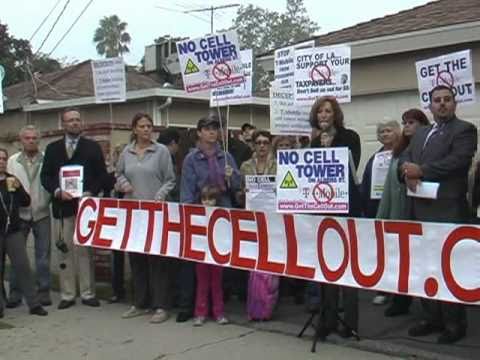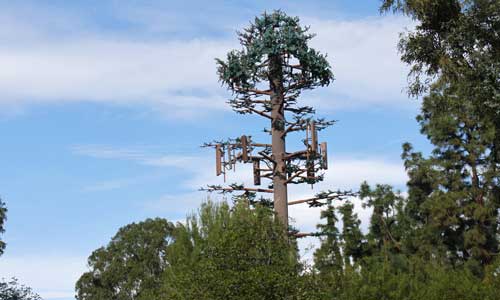Fake Metal Trees
Despite the obvious advantages of cell towers for communication, they're a common source of tension for local communities. Here's why.
94%

Why are cell towers so freaking controversial, anyway?
Much like a metro line or a landfill, cell towers are a necessary fact of modern life, but people don't want them near where they live, because it might bother their routine or shake things out of whack.
There are two key reasons for this: They're considered ugly, and they're perceived to have negative health effects due to potential radiation risks.
In the case of the former issue, much of the issue involves the fact that they're often extremely tall and made of metal. In the wrong location, they can ruin the look of a local area, something that could drive down property values, while creating lots of complaints in the process.
The latter issue, however, is something of a wildcard—something of an effect of the "shoot first, ask questions later" situation that we saw when cell towers first took over the world. Now, we're at the point where we're asking questions—and many of those questions feel a tad conspiratorial.
During the process of researching this piece, I repeatedly ran into activist websites where people claimed all sorts of things about these towers—that they could endanger our kids, that they could threaten our society, or that they could give the whole neighborhood cancer.
Despite these fears, the research (so far, at least) has generally not supported these fears. With cell towers being relatively new parts of our society, there's still some wiggle room in there—which is why you'll run into stories suggesting using phones is a cancer risk—including a World Health Organization fact sheet that uses the word "possibly" basically as a hedge.
But scientists and doctors generally believe that there's not much to worry about.
"Levels of energy from RF waves near cell phone towers are not significantly different from the background levels of RF radiation in urban areas from other sources, such as radio and television broadcast stations," the American Cancer Society explains.
No matter who's right or wrong on that debate, the responses sometimes get a bit, shall we say, out of whack. Do a search for Google News for "cell tower fight," and you'll find a lot of angry people.
"Nothing compares to a neighborhood cell tower fight," the Lawrence Journal-World's Peter Hancock wrote last month. That anger radiates, man.
Five great moments in cell tower NIMBY history
- Earlier this year, the U.S. Supreme Court decided in favor of T-Mobile after Roswell, Georgia's city council refused to allow the company to build a cell tower without properly explaining why it denied the request. When asked how it would handle this loss at the Supreme Court, the city's attorney, David Donaldson, casually brushed off the entire case: "It won’t be hard to comply. We just won’t send them the decision until we have the minutes ready for the meeting." Why not just do that in the first place? Did you just want to challenge a case in front of the Supreme Court?
- Back in June, a judge granted a preliminary injunction that stopped the building of a cell tower on a little league baseball field in Palo Alto, California. A victory for critics of cell towers, but one with some fairly absurd moments. See, Verizon simply wants to replace a pole that's already there with a slightly taller pole. But critics are so upset about this change that they at one point tried to get the park designated as historic, based on the fact that Ty Cobb once visited there 60 years ago.
- In 2013, a Vermont couple won $1 million in a trial against the Vermont Electric Power Corporation after the company built a communications tower on their mountaintop property. “All we wanted was to be left alone on our mountain,” Olga Julinska said after winning the case.
- Earlier this year, a number of fire fighters in Los Angeles won a victory against a plan to put cell towers on fire stations throughout the city—towers meant to improve emergency service in the country's second largest city.
- The greatest moment, however, came in 2007, when an Australian man concerned about the health effects of cell towers decided to solve the problem by taking a tank and destroying as many cell towers as he could. Despite spending years in jail for the action, he's not sorry.
$150k
How wireless companies try hiding cell towers in plain sight
In November 2011, a very large pine tree started towering over the campsites at Muskegon, Michigan's Elks Park.
The tree was 155 feet tall, and if you were to walk up to it, it'd feel like you were touching bark.
That tree was hiding something, however—a cell tower for Verizon. Despite its height, the tower went out of its way to blend into the local surroundings, even including 18,000 pounds of artificial branches, just to ensure the look was on point. The goal, of course, is to ensure that the average person doesn't see the forest for the cell towers.
"It tends to be when there's some sensitive landscape or if you're building it in an area where there's a beautiful view and you want something to blend in," a Verizon spokesperson told the Muskegon Chronicle of the decision-making process that follows adding in the unusual foliage.
It's far from the only tower of its kind—near the Las Vegas region, a giant fake windmill is keeping bars alive. A company called Americlock creates large decorative clocks designed to hide cell towers inside. If you see a water tower hanging out somewhere, there's a chance it may either be doubling as a cell tower, or not actually a water tower at all. And that flagpole? Probably a cell tower.
Churches are even finding that cell towers make for a pretty solid secondary source of income.
"Nobody can tell that they’re there unless they’re sharped-eyed and looking for them," noted Pastor Martin Scales of San Ramon, California's Canyon Creek Presbyterian Church.
"I do realize that AT&T needs this cell phone tower—we're not against the tower itself. It just doesn't need to be so close to our homes. Apart from the tower being so tall, we all feel that property values will go down if they build it so close. Most people I know wouldn't want to buy a house near a cell phone tower."
— Cory Barham, a resident of Mesa, Arizona, getting to the heart of the issue in a 2012 interview with AOL. Barham and his neighbors were upset about a planned cell tower in the neighborhood—essentially being built at the behest of the Federal Communications Commission to fill a gap in coverage—despite the fact that it was dressed up like a palm tree. Because, let's be honest, a 70-foot-tall palm tree is pretty obviously a cell tower.
For all the people who complain about the number of cell towers out there, it's worth keeping in mind that without them, we'd basically be screwed. No better is this point exemplified than in the tiny town of Sherwood, Tennessee, which to this day can only really rely on landlines to communicate with the outside world.
This proved a problem after a recent train derailment, noted Sheriff Tim Fuller.
"I'm over there and I have no communications so I've got to either go to somebody's house or there's one store over there. Or I've got to drive back to the top of the mountain to get a signal," Fuller recently told the Chattanooga Times Free Press.
This situation will likely soon change, as residents are currently discussing installing a cell tower in the town. No word on whether they plan to go with the palm tree or the decorative clock.
:format(jpeg)/2018/04/k0mrhbtzh8ggs0n1g8vj.gif)
/2018/04/k0mrhbtzh8ggs0n1g8vj.gif)


/uploads/ernie_crop.jpg)